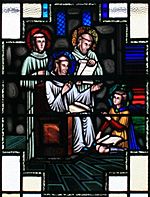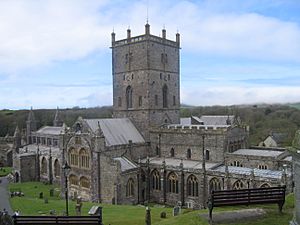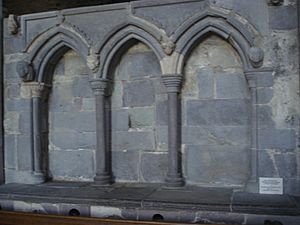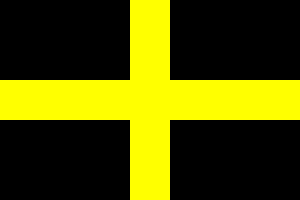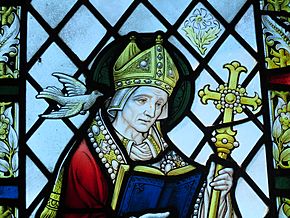Saint David facts for kids
Quick facts for kids Saint David |
|
|---|---|
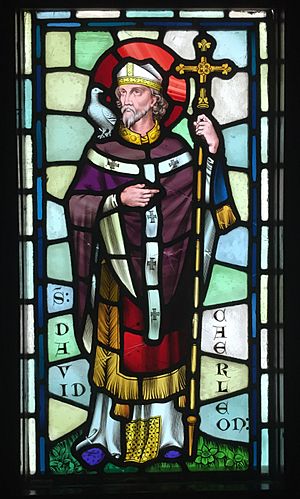
|
|
| Bishop of Mynyw | |
| Born | Unknown, estimated at c. 500 Unknown, c. Caerfai, Dyfed or somewhere in Caredigion. |
| Died | 1 March 589 Mynyw, Dyfed |
| Venerated in | Roman Catholic Church Eastern Orthodox Church Anglican Communion |
| Canonized | 1123, Rome, Holy Roman Empire (officially recognised) by Pope Callixtus II |
| Major shrine | St David's Cathedral, Pembrokeshire, Wales shrine largely extant, controversial bones in casket |
| Feast | 1 March |
| Attributes | Bishop with a dove, usually on his shoulder, sometimes standing on a raised hillock |
| Patronage | Wales; Pembrokeshire; Naas; vegetarians; poets |
| Controversy | The earliest of the supposed bones of Saint David and Saint Justinian housed in a casket in the Holy Trinity Chapel of St David's Cathedral have been carbon-dated to the 12th century. |
Saint David (in Welsh, Dewi Sant; in Latin, Davidus; born around 500 AD, died 589 AD) was a Welsh bishop who lived in the 6th century. He was based in a place called Mynyw, which is now known as St Davids. He is the patron saint of Wales, meaning he is considered a special protector or guide for the country.
David was born in Wales, and we know quite a bit about his life through old stories. However, the exact year he was born is not certain, with guesses ranging from 462 to 512 AD. People traditionally believe he was the son of Saint Non and the grandson of Ceredig ap Cunedda, who was a king of Ceredigion.
Contents
The Story of Saint David
Many of the traditional stories about David come from a book called Buchedd Dewi, which means "Life of David." This book was written by a person named Rhygyfarch in the late 1000s. Rhygyfarch said he based his book on old documents from the cathedral. Today, some historians are not sure if all the stories are completely true. For example, Rhygyfarch wanted to show that the Welsh church was important and independent.
It is likely that David was born in a place called Henfynyw in Ceredigion. He became famous as a teacher and speaker. He started many religious communities and churches in Wales, Dumnonia (an old kingdom in southwest England), and Brittany (in France). Today, St David's Cathedral stands where he founded his monastery in Pembrokeshire.
Around 550 AD, David attended a meeting called the Synod of Brefi. Here, he spoke very well against a belief called Pelagianism, which was about how people become good. His powerful words led his fellow monks to choose him as their leader in the region. He also led another important meeting, the "Synod of Victory," around 569 AD.
David's Miracles and Teachings
David's most famous miracle happened when he was speaking to a large crowd at the Synod of Brefi. The ground beneath him is said to have risen up, forming a small hill. The village of Llanddewi Brefi is now located at this spot. During this event, a white dove, which became his symbol, was seen resting on his shoulder.
David taught his followers to live a very simple life. His rules for monks included pulling the plough themselves instead of using animals. They were only allowed to drink water and eat bread with salt and herbs. Monks spent their evenings praying, reading, and writing. They were not allowed to own anything personal; even saying "my book" was considered wrong. He taught his followers to avoid eating meat and drinking beer.
David and Glastonbury
Some stories say that David founded Glastonbury Abbey in England. About 40 years later, another writer, William of Malmesbury, said that David only visited Glastonbury to bless the Abbey again. He also donated a special traveling altar with a large sapphire. William wrote that David had a vision where Jesus told him that the church had already been blessed by Jesus himself. So, instead of re-blessing it, David asked for an extension to be built onto the abbey.
His Last Days and Legacy
The exact date of Saint David's death is not known for sure, but tradition says it was on March 1st. This is why Saint David's Day is celebrated on March 1st every year. The two most common years given for his death are 601 AD and 589 AD. Stories say that when he died, his monastery was "filled with angels."
His last words to his followers were spoken in a sermon the Sunday before he died. In Welsh, they are: "Arglwyddi, brodyr, a chwiorydd, Byddwch lawen a chadwch eich ffyd a'ch credd, a gwnewch y petheu bychain a glywsoch ac y welsoch gennyf i. A mwynhau a gerdaf y fford yd aeth an tadeu idi." This translates to: "Lords, brothers and sisters, Be joyful, and keep your faith and your creed, and do the little things that you have seen me do and heard about. And as for me, I will walk the path that our fathers have trod before us." The phrase "Do ye the little things in life" (Gwnewch y pethau bychain mewn bywyd) is still very famous in Wales today.
David was buried at St David's Cathedral in St Davids, Pembrokeshire. His shrine there became a very popular place for people to visit on pilgrimages throughout the Middle Ages. During the 10th and 11th centuries, Vikings often raided the Cathedral. They would take the shrine and strip off its valuable metal decorations. In 1275, a new shrine was built. Its ruined base can still be seen today. The bones of David and Justinian of Ramsey Island were kept in a special box on this stone base. In 1284, King Edward I of England came to pray at this shrine. Later, during the Reformation, a bishop named Barlow took away the shrine's jewels and the bones of David and Justinian.
How He is Remembered
David was officially recognized as a saint by Pope Callixtus II in 1120. This happened thanks to the efforts of Bernard, who was the Bishop of St David's at the time. The Eastern Orthodox Church also recognized David as a saint, though the exact date is not known.
More than 50 churches in South Wales were named after him before the Reformation.
In a book called the Roman Martyrology (a list of saints), David is listed under March 1st. He is described as a bishop from Wales who led his monastery following the example of early Christian leaders. Because of his leadership, many monks went out to share Christianity in Wales, Ireland, Cornwall, and Brittany.
The rebuilt Shrine of Saint David was revealed and blessed again on Saint David's Day in 2012.
A traditional story from around 1630 says that the Welsh wore leeks in their hats to remember a battle fought on St David's Day. To tell friends from enemies, the Welsh supposedly picked leeks from a garden and put them in their hats before winning the battle.
Saint David is usually shown standing on a hill with a dove on his shoulder.
Saint David's Impact
David's popularity in Wales is clear from an old poem called Armes Prydein, written around 930 AD. This poem predicted that in the future, when all seemed lost, the Welsh people (called Cymry) would unite behind David's banner to defeat the English. The poem says: "A lluman glân Dewi a ddyrchafant" ("And they will raise the pure banner of Dewi").
David is also believed to have helped spread Christianity in other parts of Europe. Many place names in Brittany, like Saint-Divy, Saint-Yvi, and Landivy, are thought to be named after him.
David's life and teachings have inspired music. A Welsh composer named Karl Jenkins wrote a choral work called Dewi Sant. Another Welsh composer, Arwel Hughes, also wrote an oratorio (a large musical work) called Dewi Sant in 1950.
Saint David is also linked to stories about corpse candles. These were mysterious lights that were said to warn people that someone in the community was about to die. The story says that David prayed for his people to have a warning before death so they could prepare. In a vision, his wish was granted. From then on, people in the land of Dewi Sant "would be forewarned by the dim light of mysterious tapers when and where the death might be expected." The color and size of the lights would even show if the person to die would be a woman, man, or child.
See also
 In Spanish: David de Gales para niños
In Spanish: David de Gales para niños
- Saint David's Day & Proposed St David's Day bank holiday
- St Davids, Pembrokeshire & Saint David's Cathedral
- Saint David's Castle & St David's Church, Naas
- Saint Divy Parish close, Brittany
- Saint David, patron saint archive
- Proposed origins of the tale of Davy Jones' Locker


